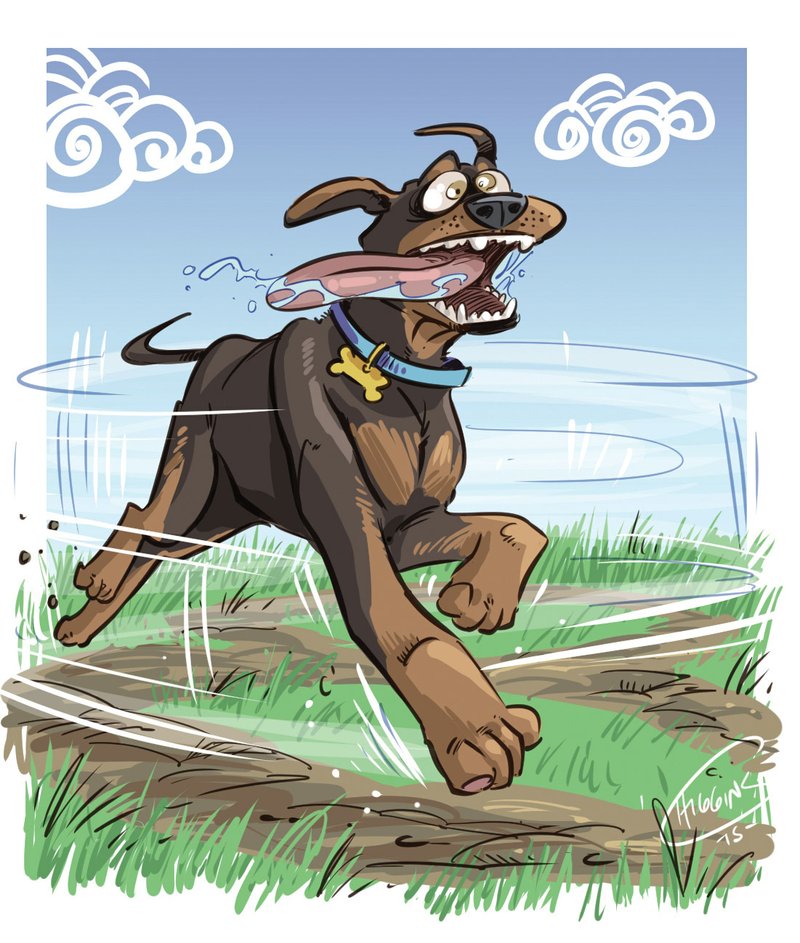We have a dog who likes to run in circles, and then reverses and goes the other way. This circle is about 14 feet across and has removed all the grass so is quite muddy after all the rain we’ve had. Someone has labeled him “crazy,” but I don’t think so. He’s quite lovable and fun. He is a full-grown Doberman and we have no clue as to what’s wrong. Any ideas?
Let’s see : An adult Doberman wanting to run doesn’t sound crazy at all. His behavior appears to have all the characteristics of a “zoomie,” an episode in which a dog goes on a tear around the yard or even in the house for no apparent reason.
Veterinarian Marty Becker says on Vetstreet.com that the zoomie also has a more technical name: frenetic random activity period or FRAP. Becker says dogs of all ages experience FRAPs or zoomies. These spurts of activity may be random or even occur at a certain time every day. My family once had a beagle that would jump up suddenly at about 6 p.m. every day and zip around the yard for several minutes. She eventually wore a figure-8 pattern into the grass. Nothing was wrong with that beagle; she simply needed to burn some energy.
Like beagles, Dobermans are high-energy dogs that require a lot of exercise, according to the American Kennel Club. Dobermans are working dogs, originally bred to be guards and sentries. Working dogs without jobs — most pets, in other words — need an outlet for their mental and physical energy. If they aren’t given something to do, they’ll find something. Some dogs become destructive, but others are like your dog and indulge in zoomies.
While it may not bring back your grass, making sure your Doberman gets plenty of mental and physical stimulation could curb his tendency to run in circles. Take him for long walks daily or for play sessions at a local dog park. If he likes to play fetch, schedule a couple of sessions a day. Dobermans also do well in training for agility courses where they leap over hurdles, jump through rings and navigate a variety of obstacles.
However, there’s always the possibility that the circling behavior could be something more than merely a need for more exercise. If it appears obsessive and the dog can’t be distracted from the activity, you might need to consult a certified animal behaviorist or professional dog trainer. You would also want to consult a veterinarian to rule out any health-related issues.
Dogs aren’t the only animals that enjoy the occasional, even daily, zoomie session. I sometimes hear from cat owners asking why their cats seem to go insane at times and zoom through the house in rip-roaring runs complete with acrobatic leaps on and off furniture. Although the behavior is sometimes a reaction to something a cat sees or hears (perhaps another animal through a window), the reason often is that the cat needs to blow off steam.
Feline behaviorist Pam Johnson-Bennett says in her book Think Like a Cat that cats benefit from daily exercise or play sessions just as dogs do. Play sessions not only strengthen the bond between owner and cat, but also keep the furry one happy and healthy. She suggests interactive play sessions in which the owner lets the cat stalk and attack a teaser toy (usually feathers attached to the end of a stick). During play, the owner can make it more entertaining by making bird noises and varying how the stick moves. She says owners shouldn’t keep the toy on the ground or in the air all the time, but bounce it or move it in and out of a cardboard box.
If a cat is more of a napper than a zip-though-the-house pet, the owner may have to entice him to play by using catnip. Catnip, an herb that releases pleasure-inducing hormones in the brain, can get a cat up and moving. Cats usually react to catnip instantly and roll, jump and play as if they are kittens again. The effects wear off in about 15 minutes, after which cats are happy and relaxed.
Johnson-Bennett says, however, that catnip-scented toys shouldn’t be left out at all times. That’s not because there are any ill effects, but because constant exposure can make a cat immune to catnip’s effects. She advises exposing a cat to the minty herb no more than once a week.
Do you have a question about pets? We’ll get you an answer from an authority. Send your question to Rhonda Owen, Arkansas Democrat-Gazette, P.O. Box 2221, Little Rock, Ark. 72203 or email
askcreature@att.net
